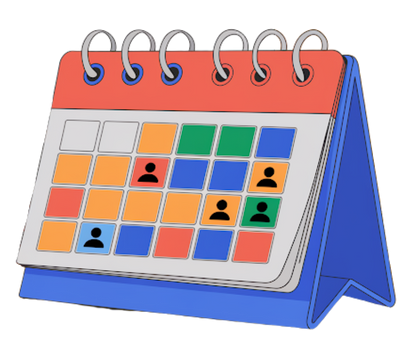Employees are the most valuable asset of any company. But without a well-structured capacity plan, teams can quickly become overworked, leading to lower productivity and growing frustration. At the same time, unused resources cause inefficiencies and unnecessary costs.
Many organizations struggle to strike the right balance between full utilization and overload. So how can effective employee capacity planning help you distribute workloads fairly, avoid bottlenecks, and create motivated teams for the long term?
In this article, you'll learn how to optimize your employee resource planning and build a strategic foundation for greater efficiency and satisfaction within your company.

Common Challenges in Employee Capacity Planning
Capacity planning is one of the most critical tasks for leaders to ensure smooth and efficient operations. Yet finding the right balance is often easier said than done.
Too little capacity results in overload and stress. Too much capacity leads to wasted resources and reduced productivity. Over time, poor planning damages employee engagement and overall company performance.
Some frequent problems caused by inaccurate or inefficient planning include:
-
• Employee Overload
When tasks are poorly distributed or teams are consistently understaffed, the workload on individuals rises sharply. This leads to stress, higher error rates, and even burnout over time.
Real-world example: A sales team faces a sudden 30% surge in inquiries due to aggressive growth targets. Without structured staff capacity planning, employees quickly become overwhelmed, response times suffer, and customer satisfaction declines.
-
• Unproductive Downtime
On the flip side, poor capacity planning can cause employees to sit idle. A lack of tasks or poorly coordinated projects leaves valuable working hours unused.
Real-world example: A software company experiences fluctuating project volumes without long-term planning. During busy periods, there’s a shortage of staff, but during slow periods, employees are underutilized.
-
• Lack of Resource Transparency
Without clear visibility into employee availability—both current and future—planning becomes guesswork.
Bottlenecks are often detected too late, when proactive solutions are no longer possible.

How to Implement Strategic Employee Capacity Planning
-
• Forward Planning Instead of Reactive Firefighting
Successful companies invest in long-term capacity planning for employees. Rather than simply reacting to problems, they anticipate resource needs early and allocate strategically.
Factoring in seasonal fluctuations, vacation periods, illnesses, and increased project demands allows businesses to maintain optimal capacity. This proactive approach results in smoother workload distribution and greater employee satisfaction.
Instead of rushing to hire temporary staff or relying on overtime during peak periods, companies can adjust capacity flexibly—keeping productivity high without overburdening their teams.
Tip: Use historical data to predict seasonal patterns and recurring bottlenecks. Data-driven capacity planning allows you to adjust proactively, not reactively.
-
• Clear Prioritization: Not All Tasks Are Created Equal
Employee capacity planning isn't just about distributing work—it’s about making sure your resources are focused on the right priorities.
Not every task has the same level of urgency or importance. By categorizing tasks based on their strategic impact and urgency, you ensure your employees are working on what matters most.
For example, urgent client projects may take precedence over internal admin work. When you assign employee capacity based on strategic priorities, your most valuable resources stay focused where they drive the biggest business impact.
This boosts efficiency, minimizes distractions, and helps employees understand how their work contributes directly to company goals.


Benefits of Automated Employee Resource Planning
-
Boost Efficiency Through Smart Use of Capacity
Effective employee capacity planning is much more than assigning tasks. It’s about matching employee strengths and skills with the right tasks to maximize results.
When employees work on tasks aligned with their expertise, their motivation and efficiency soar. Conversely, assigning them tasks outside their specialty reduces both engagement and effectiveness.
Smart matching means better project outcomes, higher job satisfaction, and greater team engagement.
Additionally, precise planning prevents waste: Many companies experience times when some teams are overloaded, while others are underutilized. Balanced workload distribution ensures no one is burdened with low-priority tasks or sitting idle.
Results:
- • Less downtime
- • Maximized productivity
- • Significant increases in overall company efficiency
Outcomes at a glance:
- • Higher productivity
- • Faster project completions
- • Better deadline adherence

Fewer Sick Days Through Healthy Workloads
One of the biggest challenges companies face is balancing workload with employee well-being.
If workloads aren’t carefully planned, employees often face overwhelming demands, leading to stress, burnout, and ultimately more sick days. Balanced employee capacity planning keeps workloads at a sustainable level. This protects not just employee health, but also motivation and long-term engagement.
Healthy work environments foster well-being, drive higher performance, and minimize costly, long-term absences.

Better Scalability and Growth Planning
Strategic, forward-thinking capacity planning is crucial for sustainable growth. Strategic, forward-looking capacity planning is critical for sustainable business growth. If you plan your staffing needs early and carefully, you not only avoid immediate bottlenecks but also ensure you're ready to scale your business and adapt to market changes.
Great capacity planning involves forecasting future needs—not just covering today's workload. When your company grows, so do the demands on your teams and resources.
By planning ahead, you’ll know exactly when and where additional employees are needed to keep pace with growth. This allows you to scale smoothly without risking employee burnout.
Flexible planning also enables you to react faster to market shifts or client demands. Whether it's hiring new talent or partnering with external providers, you're better prepared to respond quickly and strategically.
Bottom line:Employee capacity planning not only prevents short-term overload but also builds a strong foundation for sustainable, competitive growth in a dynamic market.

Why a Digital Solution for Employee Capacity Planning Makes Sense
The days of Excel spreadsheets and manual tracking are over. Modern capacity planning tools allow you to manage resources in real time, detect bottlenecks early, and plan with greater confidence.

Strategic Employee Capacity Planning Pays Off
Effective capacity planning ensures optimal workload distribution and helps you avoid both employee burnout and wasted downtime.
Key Takeaways:
- ✔ Proactive planning prevents bottlenecks
- ✔ Clear task prioritization drives efficient workflows
- ✔ Dynamic resource allocation makes companies more agile
- ✔ Digital tools provide real-time transparency and scalability
If you optimize your employee resource planning strategically, you’ll boost productivity and foster happy, motivated teams.
Ready to improve your planning?
Use modern tools like CapaPlanner to optimize resource allocation, plan more efficiently, and prevent bottlenecks—for sustainable business growth.


